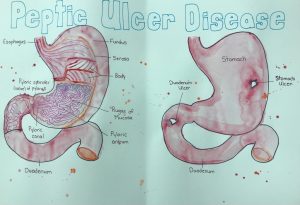For my STEAM project, I decided to create two watercolor paintings. One painting with a stomach and duodenum that is healthy and one with stomach and duodenum ulcers. I decided to create these paintings to show a visual representation of a healthy stomach and duodenum in comparison to one that has ulcers. My goals are to show the anatomy of the stomach and to explain the possible causes, symptoms, and treatments of peptic ulcers. Peptic ulcers can be very painful and a person who has them can be in a great amount of pain which requires a doctor’s visit and specific medication to heal properly. This information can be very beneficial to know in the long run because people can know how to prevent the issue and even diagnose themselves if this happens to them.


Markuss did his STEAM project on peptic ulcer disease. The visual aid shows one healthy stomach and duodenum and one stomach and duodenum that has peptic ulcers. A peptic ulcer is an open sore in the lining of the stomach or duodenum, the first segment of the small intestine. These ulcers have multiple causes, but the two most common causes are Helicobacter pylori infection and the misuse of NSAIDs. The bacterium, H. pylori, weakens the protective mucous coating in the lining of the stomach and duodenum. With a weakened mucous coating, stomach acid can get through the sensitive lining of the stomach and cause ulcers. Once there is an open sore, both the bacteria and the stomach acid continue to irritate the stomach lining, worsening the condition if left untreated. H. pylori usually infect the stomach in childhood. One of the first things doctors test for when a patient has symptoms of a peptic ulcer is an H. pylori infection. The infection is treated with antibiotics. The second most common cause of peptic ulcer disease is the misuse or overuse of NSAIDs such as aspirin, ibuprofen, and naproxen. Peptic ulcers caused by NSAIDs are typically caused by long-term use at high doses to manage chronic conditions. For example, a person dealing with chronic migraines may take Excedrin daily to manage the pain. This long-term use of Excedrin puts this person at higher risk for developing peptic ulcers. If left untreated, these peptic ulcers can lead to internal bleeding that can cause anemia.